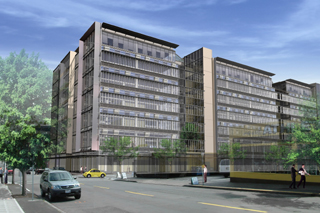
DJC.COM
March 2, 2006
Biotech developers are going green
Vulcan

Buker
|
As the biotechnology industry continues to grow in Washington state the potential implications for sustainable developments and environmentally friendly designs are especially significant.
Seattle's burgeoning South Lake Union neighborhood is expected to become an epicenter for world-class life sciences research companies. It is already home to some of the world's research leaders in health care and life sciences, including the Fred Hutchinson Cancer Research Center, Bill & Melinda Gates Foundation, University of Washington Medicine, Seattle Biomedical Research Institute and Rosetta Inpharmatics/Merck.
With more such companies establishing roots in South Lake Union — at a time when energy prices are climbing — it becomes even more important to develop resourceful, energy-efficient and cost-effective solutions for building state-of-the-art biotech laboratories that help lay the foundation for long-term economic growth.
Seattle a green leader

Image courtesy of Vulcan
A concept building called GreenLab was developed to show how sustainable designs can save energy and conserve resources. According to a, GreenLab would use 50 percent less energy than a typical Seattle laboratory building — a savings of nearly $600,000 a year.
|
Green projects spanning virtually every sector of the real estate industry have been designed and constructed with increasing frequency around the world. The U.S. Green Building Council's Leadership in Energy and Environmental Design (LEED) system has also been instrumental in accelerating the adoption of sustainability measures in the building industry.
The city of Seattle has been at the forefront of implementing sustainable building requirements and environmental standards, with Seattle becoming the first city in the nation to adopt a citywide sustainable building policy in 2000.
As the leading city in green building design — Seattle has delivered more LEED-certified projects than any other city — we now have the opportunity to extend our sustainable leadership into the biotech sector by promoting environmentally responsible laboratories.
What's driving this increasing trend towards going green?
Several qualitative studies and numerous real-world examples have confirmed the positive impact that sustainable projects have had in the workplace and community.
Not only do "high-performance" sustainable buildings minimize harm to air and water quality and help protect natural ecosystems, but they also make good business sense by increasing a building's return on investment and lowering overall operating costs.
Pleasant views, fresh air, natural daylight, the use of nontoxic building materials and the ability to control personal climate areas can all help improve a company's bottom line by maximizing energy conservation and enhancing occupant comfort and health — boosting employee productivity and satisfaction in the process. It is estimated that increasing productivity by just 1 percent will cover an employer's annual energy costs.
SBRI sets example
A prominent example of how this latest approach is taking shape in the Puget Sound region is the Seattle Biomedical Research Institute (SBRI) building in South Lake Union. Developed by joint-venture partners Vulcan, SBRI and Harbor Properties, the 112,000-square-foot building is a sustainable, five-story biomedical research facility with ground-level retail.
The SBRI building is the nation's first silver-level LEED-certified core-and-shell lab building. Its sustainable features include nontoxic building materials, fresh air, water and energy conservation, and recycled construction waste.
The exterior was constructed with recycled materials when feasible. The building is now home to more than 200 researchers and other employees that focus on infectious disease research.
"Being environmentally friendly makes the SBRI building more employee-friendly as well," said SBRI President Ken Stuart.
"SBRI's more than 200 employees all get to enjoy great views, fresh air and natural daylight, as well as benefit from the use of nontoxic building materials. Our goal was for the building to be a benefit for our employees, our community and our environment, and we've achieved that."
The building demonstrates that collaborative teams can build sustainable projects that effectively use design elements to help create a vibrant neighborhood connection and a more active, engaged community.
New green building model
Sustainable building practices that optimize performance require an integrated, multidisciplinary design process and a holistic approach that considers the building's entire life cycle — from planning, design and construction to operation and maintenance, renovation and demolition or building reuse.
Harnessing the collective expertise of developers, architects, contractors and engineers from the outset is critical for green building concepts to succeed in the real world.
With these considerations in mind, Vulcan Real Estate, Perkins + Will, and a panel of other local experts involved in lab building design and construction embarked on a self-funded, collaborative research effort last year to develop a highly functional and environmentally responsible biotechnology research facility. The interdisciplinary project team also partnered with the Seattle City Light, which funded the energy modeling used in this process.
After evaluating numerous approaches, the team ultimately developed a prototype biotech lab design known as GreenLab that incorporates a number of sustainability measures that maximize energy efficiency, conserve resources and provide a healthier, more appealing work environment.
The proposed 194,000-square-foot facility would be centrally located in South Lake Union as part of a vibrant biotech community. GreenLab would feature natural ventilation of all office spaces and non-lab areas, energy-efficient appliances and fixtures, daylighting of office spaces and labs, stormwater collection and reuse systems, and a continuous monitoring system to control air quality.
Measuring results
How do these green measures translate into concrete savings? Based on results from completed energy and cost modeling, the GreenLab concept is estimated to reduce energy consumption by up to 50 percent compared to a baseline building shell representing a laboratory in Seattle, accounting for nearly $600,000 in annual cost savings. At this rate, the GreenLab building is expected to pay for its energy-saving features in approximately eight years or less.
Beyond the significant cost savings, sustainable buildings that respect the environment are also inherently better neighbors that can help foster a stronger connection to the surrounding community.
The GreenLab design offers maximum visibility and pleasant views from both inside and out that animate the streetscapes and create greater pedestrian intimacy. For example, GreenLab's linear atrium can be viewed from outside, and water-efficient landscaping contributes to the building's overall visual appeal.
Developing a cutting-edge biotech facility that is environmentally conscious not only provides the ideal backdrop to make breakthrough discoveries, but also helps draw top talent who tend to be attracted to work environments that embrace sustainable values.
Seattle's development and design community now has an unprecedented opportunity to elevate the city's leadership in green building to the next level by creating a new model for sustainable biotech facilities.
Through careful planning and an integrated approach, we can substantially reduce harm to the natural environment while promoting the economic and social well-being of a community. As green buildings gain wider acceptance in the biotech industry, entire neighborhoods and their residents and employees stand to benefit from this new age of sustainable design.
Victoria Buker is a senior project manager at Vulcan, which is developing nearly 60 acres in Seattle's South Lake Union neighborhood.
Other Stories:
- WSU looks to ramp up biotech development
- Public spaces put a friendly face on lab building
- Biotechs differ in needs for space and power
- UW's first DBOM building almost done
Copyright ©2009 Seattle Daily Journal and DJC.COM.
Comments? Questions? Contact us.